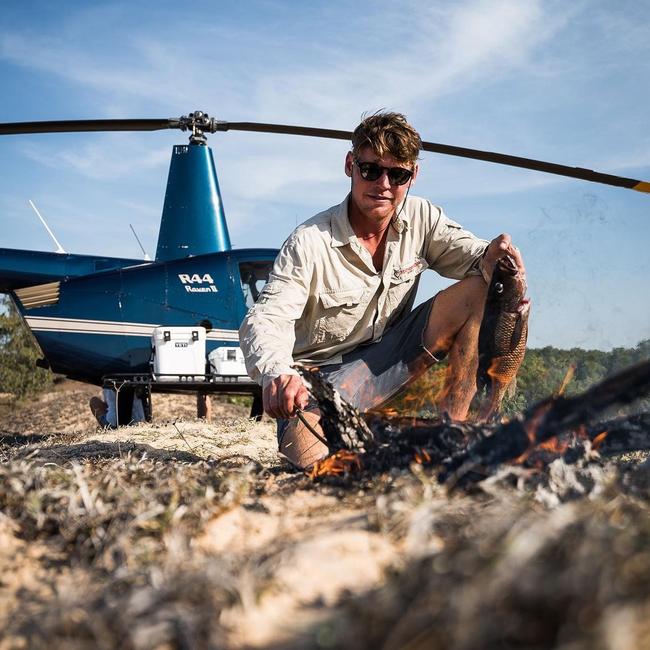Australian Transport Safety Bureau releases early findings into West Arnhem chopper crash
A safety watchdog has released their early findings into the chopper crash which claimed the life of Outback Wrangler crew member and father Chris Wilson.
Northern Territory
Don't miss out on the headlines from Northern Territory. Followed categories will be added to My News.
THE last time fellow croc egg collectors saw Chris Wilson, he was flying through the sky, suspended 30m from a chopper dangling over a croc-filled river.
Ninety minutes later the Territory father and Outback Wrangler crew member was dead.
His body discovered 40m from the wreckage of a Robinson R44 deep in a paperbark swamp along the King River.
On Tuesday, the Australian Transport Safety Bureau (ATSB) released its preliminary investigation into the fatal helicopter crash, which killed Mr Wilson and critically injured his pilot, Sebastian Robinson on February 28.
The ATSB found the engine of the Robinson R44 helicopter stopped before it hit the ground near the King River, West Arnhem.

The latest report detailed the evidence established in the investigation’s early evidence collection phase, including the timeline in the lead up to the crash.
It said Mr Wilson and Mr Robinson were part of a trio of helicopters collecting crocodile eggs in Arnhem Land under contract to Wildlife Harvesting.
Their Robinson R44 was one of two of the choppers used to collect eggs, while the third helicopter was assigned to transporting the delicate cargo.
After leaving Noonamah just after 7am the trio flew together along the King River for 90 minutes.
Mr Wilson and Mr Robinson started collecting eggs near the first staging area, and after 30 minutes the others crews headed off, 12km north east.
As an egg collector Mr Wilson was harnessed to a 30m long line, allowing him to be slung below the chopper and access the crocodile nests.
Chris ‘Willow’ Wilson farewelled loved ones in emotional funeral
Positive news as Sebastian Robinson shows signs of recovery after West Arnhem chopper crash
Australian Transport Safety Bureau to investigate West Arnhem chopper crash
The second team collected eggs from nine nests in just over an hour when worries started to creep in.
“Crew members of the other two helicopters became concerned when they had not heard any radio communications from the third helicopter,” ATSB Director Transport Safety Stuart Macleod said.
Fifteen minutes after turning back one of the pilots came across the tragic scene.
Only 300m from where they had last separated at the staging area, they saw the wreckage of the chopper.
The rotor blades were bent and twisted from where they had sliced through at least one tree in the paperbark swamp.
The once sleek white body was crumpled and dented by the collision.
Hovering down closer they would have spotted the 28-year-old pilot, found laying beside the wreckage.
Mr Wilson’s body was found another 40m from the helicopter.
The ATSB said Mr Wilson’s long line attachment rings were no longer connected to the helicopter cargo hooks.

Neither the emergency beacon or locator transmitter had been activated.
His fellow pilot reassured the badly injured Mr Robinson before taking off to just high enough to get mobile reception to call for help.
A CareFlight helicopter arrived at 12.30pm and flew him to Maningrida, before he was transported to Darwin and then to Brisbane for lifesaving treatment.
Mr Macleod said the preliminary analysis indicated the chopper was travelling northwest, and crashed shortly after it left the staging area.
Because there were no eggs on board, the ATSB estimates the crash occurred about 90 minutes before it was found, around 9am.
“Initial assessment indicated the engine had stopped prior to the helicopter colliding with the ground,” Mr Macleod said.
He said in its initial findings the safety watchdog found there were no defects of the engine likely to result in engine stoppage.
There was no visible damage to the tail rotor blades and drive system and flight control continuity was established.
The two fuel bladder tanks were intact despite breaches of the surrounding metal tanks and there was no fire.

ATSB investigators drained about 250ml of blue fuel from the main tank’s bladder, but it is suspected fuel may have leaked into the creek.
Mr Macleod said the investigation would continue to look into the cause of the crash, probing the electronic and fuel system components, refuelling practices, fuel quality, maintenance records, operational documentation and regulations.
He said survivability aspects of the crash would also be considered.
Mr Macleod said the latest report details information established in the investigation’s early evidence collection phase.
“As such does not detail analysis or findings, which will be outlined in the investigation’s final report,’ Mr Macleod said.
The ATSB said if a critical safety issue was identified during the course of the investigation, it would immediately notify relevant parties so appropriate and timely safety action could be taken.




